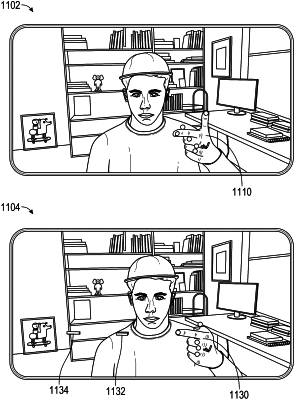| CPC G06T 19/006 (2013.01) [G06F 3/017 (2013.01); G06T 7/70 (2017.01); G06V 40/28 (2022.01); G06T 2207/30196 (2013.01)] | 18 Claims |

|
1. A method, comprising:
receiving, using one or more hardware processors, a set of frames captured by a camera of a client device;
detecting, using the one or more hardware processors, from the set of frames, a first gesture corresponding to an open trigger finger gesture;
receiving, using the one or more hardware processors, a second set of frames captured by the camera of the client device;
detecting, using the one or more hardware processors, from the second set of frames, a second gesture corresponding to a closed trigger finger gesture;
detecting, using the one or more hardware processors, a location and a position of a representation of a finger from the closed trigger finger gesture;
generating, using the one or more hardware processors, a first virtual object based at least in part on the location and the position of the representation of the finger;
rendering, using the one or more hardware processors, a movement of the first virtual object along a vector away from the location and the position of the representation of the finger within a first scene, wherein rendering the movement of the first virtual object comprises:
while rendering the movement of the first virtual object, generating a second virtual object based at least in part on a second location and a second position of the representation of the finger;
rendering a movement of the second virtual object along a second vector away from the location and the position of the representation of the finger within a first scene, wherein the first scene comprises a first representation of a real world scene, the first virtual object, and the second virtual object; and
providing for display the rendered movement of the second virtual object along the second vector within the first scene; and
providing for display, using the one or more hardware processors, the rendered movement of the first virtual object along the vector within the first scene.
|